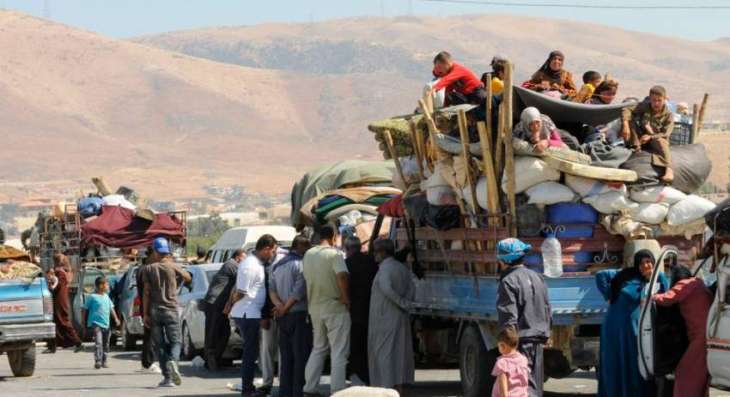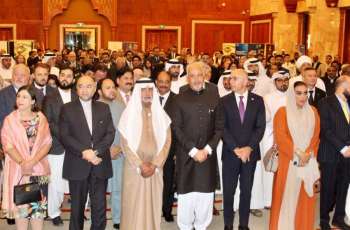A trip from Damascus to the Golan Heights does not seem safe, especially for those who fled war to neighboring countries, but the local town of Beit Jinn that just 18 months ago was reported as a strategic stronghold of armed militants is now a striking example of how life in the area has changed
BEIT JINN (Pakistan Point News / Sputnik - 14th June, 2019) A trip from Damascus to the Golan Heights does not seem safe, especially for those who fled war to neighboring countries, but the local town of Beit Jinn that just 18 months ago was reported as a strategic stronghold of armed militants is now a striking example of how life in the area has changed.Syrians who have for several years been living in southern Lebanon and refugee camps of the Beqaa Valley are still hesitating to return home. International organizations, including the United Nations, openly discourage Syrians from leaving Lebanon, saying that it is not safe for them back in Syria and warn them of risks of being exposed to pressure from the authorities.
Sputnik correspondents met with people who had come back from Beit Jinn after living there for more than a year, as well as representatives of the local administration, and militants who had agreed to lay down arms use their military expertise to fight against terrorists.
The former head of the town administration, Haisam Hammudi, met our correspondent at the entrance to Beit Jinn. Sputnik had already met him a little over a year ago on the other side of the Golan Heights in the Lebanese town of Chebaa, where he had fled to with his family and several hundred other fellow villagers in 2014.
"Kind people came to me and said that the militants wanted to arrest me. At 9 a.m. I gathered up my family and, without arousing suspicion, headed toward the side of the valley. There is a path where you can illegally cross the border. As we began our journey, we met with other refugees, more than 200 people in total, including women and children, and went to the mountains. Lebanese border guards met us three hours later and provided assistance," Hammudi recalled.
The villagers of Chebaa welcomed and housed Hammudi's family and other refugees. While they were provided with the best possible living conditions, no one imagined at the time that they would have to stay in these homes for many years.
The border villages of Syria and Lebanon in the Golan Heights have the same roots and are even inhabited by people with the same last Names. Back in 2006, the Syrians hosted Lebanese nationals who had fled war with Israel the thing same occurred in 1979 and 1982.
The Beit Jinn area is known throughout Syria as a place where you can go with your family for summer vacation and escape the city heat. Before the war, Beit Jinn welcomed numerous tourists every summer and autumn. Locals recalled that it was impossible to find a parking spot near multiple restaurants on Fridays and Saturdays.
Restoration work in Beit Jinn is now well under way. Restaurant owners have set up summer terraces again. With support of the local administration, 10 schools have been repaired to welcome not only local children but also students from nearby villages. Before the war, about 12,000 people lived in Beit Jinn and the Mazraat Beit Jinn suburb. Today, between 17,000 and 20,000 citizens, who have returned from neighboring Lebanon, live and work here.
"In 2019, we can already talk about the tourist season. Local tourists have already started to come here. Syrian Tourism Minister [Beshr Yazji] visited us two months ago. The owners of the restaurants are restoring their property, and everything is going very well. We hope that we will restore and prepare everything that our guests need by the 2020 tourist season," Hammudi's friend, Beit Jan Imad Kabalyan, told Sputnik.
Kabalyan invited Sputnik to take a walk through Mazraat Beit Jinn and see how people lived there. From the early morning, local farmers open their stalls along the main street and sell fresh fruits from their gardens. This month there are plenty of honey peaches and sweet cherries.
"Our life is stable, everything is good. All scary stories that we heard turned out to be lies. Our government met us with dignity, and the local authorities help us. Even when there were difficulties with gasoline, they brought us fuel so that we could plow fields. There is electricity and drinking water. We are gradually rebuilding our houses. There are just a few left that need restoration," one of the farmers, who returned home in 2018, said.
Hammudi, when in Lebanon, was appointed a chief of the Syrian refugee community in Chebaa. He also had a full-time job as a civil engineer.
"There were more than 500 families with me, now there are about 35 families left [in Chebaa]. The documents for their return are being processed. Of course, not everyone came back at once, as they were intimidated by false media reports about what was happening in Syria. I was among the first to return home. The Lebanese side prepared all the necessary documents for us and we were well received in Syria. They helped us get settled and gave everything we needed for the first time. Then we contacted our friends in Lebanon and said that the house is waiting and everything is fine... Now almost everyone is back," Hammudi told Sputnik.
According to him, some Syrians would prefer to stay in Lebanon, mostly those who have found a good job or because of the school curriculum. The Lebanese and Syrian authorities, in turn, are doing everything possible to dispel myths about prisons and acts of violence in Syria and to ensure that people return safely.
Until mid-2017, Beit Jinn and its surroundings were considered the last stronghold of illegal armed groups. The government ordered that a reconciliation commission be created to make it possible for the young men who had taken up arms to switch sides and help their country fight against terrorism.
Sputnik met with several men who took the chance to leave the armed militia and joined the "Hermon Regiment," which, together with the army, cleared the Golan Heights of foreign mercenaries fighting on for the Jabhat al-Nusra and Islamic State terrorist groups (both banned in Russia).
"At the beginning of the crisis, we followed the events in our country on Al Jazeera and Al Arabiya [TV channels], where they were constantly talking about crimes and murders," former militant Omar Abdel Azim from the village of Qatana told Sputnik, adding that such news stories had confused them.
The reconciliation process began in January 2017, Azim continued, saying that he had met with one of the leaders of the reconciliation commission.
"She told us what was really happening. Then we let the officers of the Syrian army into our territories. With all their actions and words, they showed us that the media distorted the reality and that we could come back," Azim added.
He noted that he was now in charge of a unit in the "Hermon Regiment."
"The regiment is the allied force of the Syrian army. It is subordinate to the army command. The reconciliation has fully justified itself, none of the guys have been subjected to pressure from any side," Azim said.
Now the pacified militants and refugees who have come back from Lebanon live next door to each other, repair infrastructure and medical facilities and rebuild houses that were destroyed in the war.
Azim and Hammudi offered Sputnik to come back to Beit Jinn again in October, when an annual carnival festival dedicated to St. George's Day begins in the nearby Christian village. Even Muslims in the area always look forward to it.




